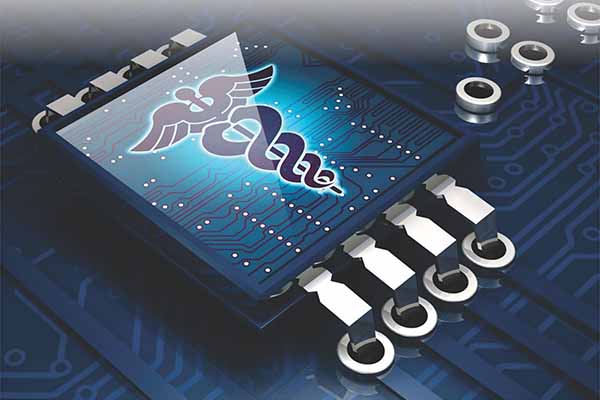Medical electronics is a specialist field that brings together engineering, biomedical sciences, and clinical practice. Medical electronics technicians, also known as biomedical equipment technicians (BMETs), are responsible for the maintenance and repair of a wide range of medical devices, including defibrillators, imaging devices, and patient monitors. Some technicians are experts in radiography or other lab equipment.
Medical gadgets are essential for performing invasive surgeries in humans to improve their quality of life. In today’s medical equipment, at least one sensor is used for healthcare monitoring.
Various sensors have been added to suit the stringent criteria of medical electronics for diagnosing and treating spontaneous disease and physiological abnormalities. In this post, we’ll look at some of the healthcare sensors that are used in the medical field, as well as their applications.
“Medical Electronics” is defined as the study of electronic tools and technologies used to diagnose and treat health problems. It is the design of embedded systems for medical and biological applications.
Sensors are crucial in bringing medical applications to life in the real world. Airflow, temperature, humidity, pressure transducers, thermometers, and other sensing devices have been demonstrated to be important for medical solutions.
Medical Electronics Engineering, which improves engineering and medical knowledge, is one of the fastest developing disciplines in current period, when people want the finest and most exact health care. Medical science analyses, treats, and cures practically all diseases, employing advanced and accurate technology to suit the people’s desire for precision. A medical electronics engineer is known as the “Doctor of Equipment’s,” since without them, a doctor, a surgeon, or a multispecialty hospital would be powerless. He or she is the expert in the mechanism, operation, and upkeep of these machines.
Medical electronics engineers use their understanding of biology and medicine with engineering concepts and practices to build devices and measurements that tackle medical and health-related issues. Many works with life scientists, chemists, and medical scientists to develop and evaluate artificial organs, prostheses (artificial devices that replace missing body parts), instrumentation, medical information systems, and health management and care delivery systems, among other systems and products.
Medical electronics engineers also create gadgets for a variety of medical procedures, imaging systems including magnetic resonance imaging (MRI), and devices for automating insulin injections and managing physiological processes. Biomaterials, biomechanics, medical imaging, rehabilitation engineering, and orthopedic engineering are some of the disciplines in medical electronics engineering. Medical Electronics Engineering Technology appeals to students who want to pursue a technological profession while also helping physicians, nurses, and hospital patients save lives. Medical electronics engineers maintain, repair, and calibrate electronic medical devices in hospitals and clinics. It is also necessary to acquire abilities in expressing issues, ideas, and solutions to other workers in order to grow in these fields. Medical technology is rapidly advancing. Medical OEMs are under more pressure than ever to deliver their products to market as quickly as possible. You’ll be able to develop quicker, increase your performance, and set the way in medical and life sciences by teaming with TT Electronics.
Commercial Applications
The commercial sector for medical electronics needs both long-term dependability and complex circuitry. Additionally, oddly shaped substrates may be required for the packaging. To be implanted in people, medical hybrids must undergo even more rigorous testing than military hybrids and be free of pollutants. Instruments for life support, patient monitoring, hearing aids, and pacemakers are included in the expansive area of medical electronics. The pacemaker market in particular has expanded fast, as have hybrid circuits as the packaging method of choice. As noted, before, size and material limits have made medical electronics a hard field for hybrid engineers.
Additionally, the computer industry makes substantial use of hybrids and MCMs. Cupertino, California-based Micromodule Systems, Inc. is a prominent provider of CPU subsystems and multichip modules. Their Spectrum CPU modules are intended for notebook PCs and other devices with a tiny form factor. Gemini and Apollo modules include an Intel Pentium CPU, Cirrus Logic Vesuvius or Intel Piet, 256 Kbytes of burst cache SRAM, and a National Semiconductor temperature sensor on a 49 54 4 mm MCM. The SRAMs are 32K 32 level two cache at 60/66 MHz Hitachi provides them as tested die. Intel also offers validated die-only components for this MCM.
Analog-to-digital (A/D) converters are the hybrid industry’s closest approach to a “standard” product. These hybrids may be found everywhere the analogue and digital worlds intersect. Hybrid technology enables the combination of the finest monolithic IC with high-precision laser-trimmed thin-film resistors to produce the most precise circuit. This enhances the application’s performance. Hybrid Systems Corporation produces an A/D converter (HS-9516-6) with a linearity error of 0.0008 percent (Fig. 10). It is a 16-bit hybrid resolution, which corresponds to one part in 65,536. It is evident from this device’s characteristics that hybrid technology is used when great precision is required. Other firms, such as Analog Devices, also manufacture high-precision A/D converters, such as the AD 1147, a 16-bit hybrid that takes half the space of its module equivalent.
We are employing electronics for diverse purposes in medical electronics in an age of electronic engineering, allowing us to adapt medical therapy. Non-medical professionals may also keep track of health issues with the use of simple medical gadgets. The engineering applications that will be created for medical electronics are listed below. These applications simplified and perfected illness detection in the medical industry. Medical electronics is one of the fastest-growing disciplines in modern period. Medical electronics are helping to develop cures and treatments for practically all ailments. Doctors and surgeons may conduct medical exams in a highly efficient manner by employing medical electronics. Medical electronics ensures that advanced equipment is delivered with accuracy. The individual who works with the functioning of various medical electronics applications is known as a medical electronics specialist. It will be impossible for physicians to diagnose a specific condition if they do not have access to medical technology.
Applications of Medical Electronics
- Anesthesia
- Respiratory monitoring
- Blood Pressure analysis
- Oxygen level measurement in the body
- Imaging in Diagnostics
- Visual Impaired scanning (Barcode Scanner)
- For understanding Health, and wellness
- Stress measurement
- Heart rate monitoring
- Monitoring Pulmonary functions
- Glucose monitoring
- Delivering Drugs
- Orthopedics
- Point of Care Analysis
- Cardiology
- Oncology
The following devices are used in medical electronics engineering.
- Blood gas analyzer
- Medical glucose Monitor
- Electronic Brain Wave Machine
- Medical heart monitors
- Infrared and Digital Thermometers
- Defibrillator for medical electronics
- Sphygmomanometer
- MRI for medical electronics
- Fetal Monitor
- Stethoscope
Career Prospects
One of the most popular career choices for students in India is biomedical engineering. Engineers and technicians in the biomedical field may find work in a wide range of settings, including medical institutions, pharmaceutical companies, government organizations, and industrial facilities. Biomedical engineers design and advise on the proper use and care of medical devices. Technical advisor positions in medical equipment firms are another option open to job seekers. Research institutions, government organizations, and universities in India, as well as in other nations, provide a wide range of possibilities for biomedical engineers. Larsen & Toubro, BPL, Wipro Medical, and Siemens are just few of the organizations that employ biomedical engineers in their R&D or sales and marketing departments. Teaching positions at universities and colleges are also available to those in this field. Both in India and abroad, there are a plethora of career paths to choose from.
Medical electronic devices include pacemakers, defibrillators, drug-releasing pumps, hearing aids, and diagnostic equipment for measuring, monitoring, and recording biological functions such as heartbeat and brainwaves, as well as a variety of other devices. The following are some of the most important criteria for medical equipment:
- Miniaturization
- Reliability (reliability is essential for implantable electronics, but also for external devices where accuracy is critical in diagnosing a patient’s condition)
- Biocompatibility and non-toxicity
- Resistance to sterilization (parts should be able to be sterilized, often more than once, without degrading electrical or physical performance).
Conclusion
In the field of medical electronics, precision measurements are essential. The most advanced medical and healthcare equipment must be used for exact analysis.















